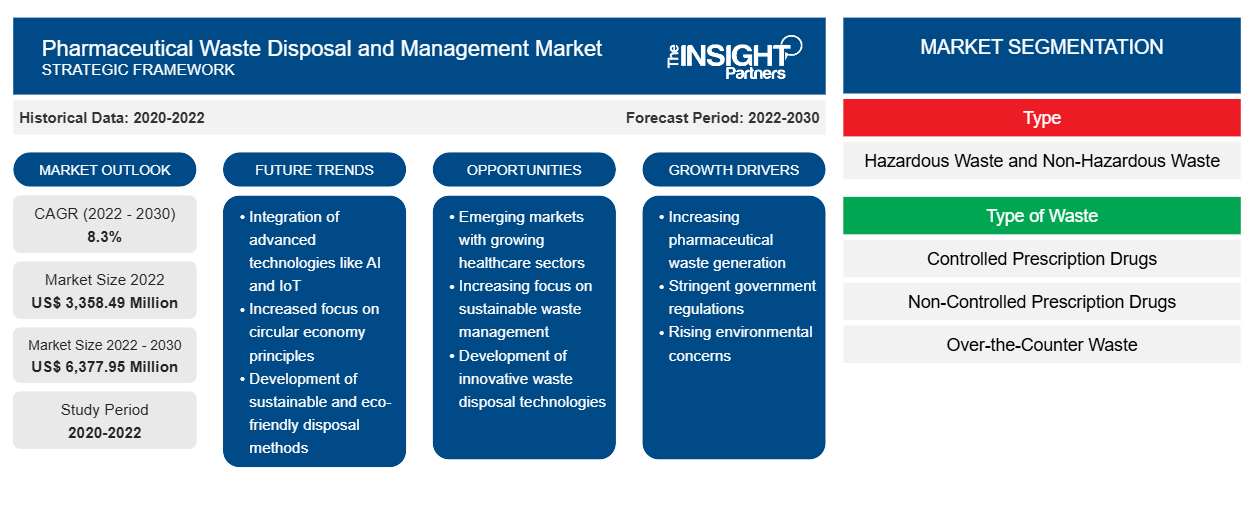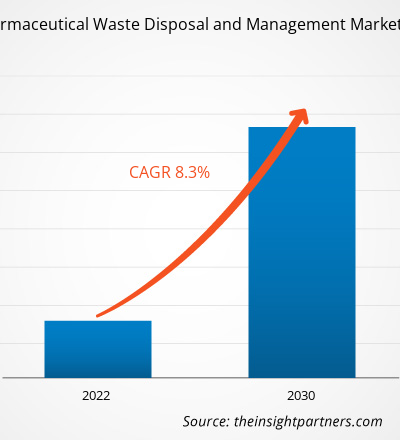[Research Report] The pharmaceutical waste disposal and management market is expected to grow from US$ 3,358.49 million in 2022 to US$ 6,377.95 million by 2030; it is anticipated to record a CAGR of 8.3% from 2022 to 2030.
Market Insights and Analyst View:
Pharmaceutical waste includes unused products or medication that has passed the expiry date. This waste may be categorized as hazardous or non-hazardous based on its chemical makeup. The categorization of medicine into pharmaceutical waste is also based on whether it poses a risk to public health or the environment. Pharmaceutical waste also includes leftover materials from their manufacturing processes and over-the-counter pharmaceuticals, in addition to prescription drugs left over due to the earlier mentioned reasons. Key factors driving the pharmaceutical waste disposal and management market growth include increasing government initiatives to promote the proper disposal of medical waste and rising awareness regarding pharmaceutical waste. However, the high cost associated with pharmaceutical waste disposal hinders market growth.
Growth Drivers and Restraints:
Large volumes of waste are produced by hospitals, clinics, and other healthcare institutions. Government efforts focused on facilitating the appropriate disposal of medical waste have increased significantly in recent years, as inappropriate management and disposal pose a rising risk to human health and the environment. The expansion of healthcare facilities and an upsurge in the production of medical waste are two major factors contributing to the surged demand for medical waste disposal and management products and services. Several governments have taken steps to control issues associated with medical waste by enacting laws and policies that guarantee a safe and appropriate disposal of medical waste. Medical waste generally needs to be disposed of properly and packaged, transported, treated, and segregated according to these rules. In the US, agencies such as the Centers for Disease Control and Prevention (CDC), Occupational Safety and Health Administration (OSHA), and US Food and Drug Administration (FDA) have designed regulations regarding medical waste. Title 49 CFR is a federal regulation focused on medical waste regulations, collection, and disposal processes and 49 CFR 173.197 focuses on regulated medical waste.
On the other hand, the high cost of the overall disposal process is a key concern for pharmaceutical waste disposal and management businesses, affecting pharmaceutical vendors, healthcare facilities, and waste management service providers. High costs are associated with each step of the disposal process, including appropriate waste packaging, segregation, transportation, treatment, paperwork, and compliance. Additionally, the high costs of disposing of pharmaceutical waste are due to the implementation of specialized protocols, regulatory compliance, and the requirement for sustainable and ethical waste management techniques.
Customize This Report To Suit Your Requirement
You will get customization on any report - free of charge - including parts of this report, or country-level analysis, Excel Data pack, as well as avail great offers and discounts for start-ups & universities
Pharmaceutical Waste Disposal and Management Market: Strategic Insights

-
Get Top Key Market Trends of this report.This FREE sample will include data analysis, ranging from market trends to estimates and forecasts.
Report Segmentation and Scope:
The global pharmaceutical waste disposal and management market is segmented on the basis of type, type of waste, and application. Based on type, the pharmaceutical waste disposal and management market is bifurcated into hazardous waste and non-hazardous waste. Based on type of waste, the pharmaceutical waste disposal and management market is differentiated into controlled prescription drugs, non-controlled prescription drugs, and over-the-counter waste. Based on application, the market is segmented into healthcare facilities, pharmacies, pharmaceutical and biotechnology companies, and others. The pharmaceutical waste disposal and management market, based on geography, is segmented into North America (US, Canada, and Mexico), Europe (Germany, France, Italy, UK, Russia, and Rest of Europe), Asia Pacific (Australia, China, Japan, India, South Korea, and Rest of Asia Pacific), the Middle East & Africa (South Africa, Saudi Arabia, UAE, and Rest of Middle East & Africa), and South & Central America (Brazil, Argentina, and Rest of South & Central America).
Segmental Analysis:
The pharmaceutical waste disposal and management market, by type, is bifurcated into hazardous waste and non-hazardous waste. The non-hazardous waste segment held a larger market share in 2022. However, the hazardous waste segment is anticipated to register a higher CAGR during 2022–2030.
The pharmaceutical waste disposal and management market, by type of waste, is segmented into controlled prescription drugs, non-controlled prescription drugs, and over the counter waste. The non-controlled prescription drugs segment held the largest market share in 2022. It is anticipated to register the highest CAGR from 2022 to 2030.
The pharmaceutical waste disposal and management market, by application, is segmented into healthcare facilities, pharmacies, pharmaceutical and biotechnology companies, and others. In 2022, the pharmaceutical and biotechnology companies segment held the largest market share. The segment is anticipated to register the highest CAGR during 2022–2030.
Regional Analysis:
Based on geography, the global pharmaceutical waste disposal and management market is segmented into five key regions—North America, Europe, Asia Pacific, South & Central America, and the Middle East & Africa. In 2022, North America held the largest share of the market. The market in North America reflects a complex landscape driven by stringent regulations, advanced waste management technologies, and a commitment to environmental stewardship. Legislation such as the US Resource Conservation and Recovery Act (RCRA) and the Canadian Environmental Protection Act (CEPA) roll out the mandatory protocols for the safe handling and disposal of pharmaceutical waste, followed by monitoring adherence to the same, which benefits the pharmaceutical waste disposal and management market growth.
Industry Developments and Future Opportunities:
Various initiatives taken by key players operating in the global pharmaceutical waste disposal and management market are listed below:
- In November 2023, Sumitomo Pharma Co., Ltd. agreed to collaborate with ORIX Eco Services Corporation as a part of an initiative to recycle blister packaging waste generated in the packaging process for prescription pharmaceuticals manufactured by Sumitomo Pharma.
- In May 2023, ORIX Eco Services became the first company in Japan to obtain an industrial waste disposal license for the stripping of blister packaging waste and other materials. Blister packaging is undertaken for the packaging of prescription pharmaceuticals, and the waste generated through this method was previously incinerated.
- In April 2022, Stericycle Inc announced its new SafeShield line of high-quality, standardized containers. These antimicrobial medical waste containers are specifically designed to store and transport regulated medical waste (RMW). These containers provide customers with better storage options, and an improved design and additional level of protection to prevent microbial growth on RMW containers. Stericycle previously began rolling out the containers to selected markets in the US after planning a phased national rollout.
- In February 2022, Republic Services Inc acquired US Ecology to expand its footprint across the US and Canada. US Ecology is a leading environmental solutions vendor for the treatment; recycling; and disposal of hazardous, non-hazardous, and specialty waste.
- In October 2020, Waste Management Inc acquired Advanced Disposal to expand its reach. Moreover, Waste Management planned to utilize Advanced Disposal’s capability to cater to approximately 3 million new commercial, industrial, and residential customers in the US.
The regional trends and factors influencing the Pharmaceutical Waste Disposal and Management Market throughout the forecast period have been thoroughly explained by the analysts at The Insight Partners. This section also discusses Pharmaceutical Waste Disposal and Management Market segments and geography across North America, Europe, Asia Pacific, Middle East and Africa, and South and Central America.
Pharmaceutical Waste Disposal and Management Market Report Scope
| Report Attribute | Details |
|---|---|
| Market size in 2022 | US$ 3,358.49 Million |
| Market Size by 2030 | US$ 6,377.95 Million |
| Global CAGR (2022 - 2030) | 8.3% |
| Historical Data | 2020-2022 |
| Forecast period | 2022-2030 |
| Segments Covered |
By Type
|
| Regions and Countries Covered |
North America
|
| Market leaders and key company profiles |
|
Pharmaceutical Waste Disposal and Management Market Players Density: Understanding Its Impact on Business Dynamics
The Pharmaceutical Waste Disposal and Management Market is growing rapidly, driven by increasing end-user demand due to factors such as evolving consumer preferences, technological advancements, and greater awareness of the product's benefits. As demand rises, businesses are expanding their offerings, innovating to meet consumer needs, and capitalizing on emerging trends, which further fuels market growth.

- Get the Pharmaceutical Waste Disposal and Management Market top key players overview
Competitive Landscape and Key Companies:
Stericycle Inc, Clean Harbors Inc, WM Intellectual Property Holdings L.L.C, Veolia, BioMedical Waste Solutions LLC, Daniels Sharpsmart Inc, US Ecology Inc, Stryker, Cardinal Health, and MedWaste Management are among the prominent players operating in the pharmaceutical waste disposal and management market. These companies focus on developing existing products and expanding their geographic presence to meet the growing consumer demand worldwide.
Frequently Asked Questions
What is pharmaceutical waste disposal and management?
What factors drive the pharmaceutical waste disposal and management market?
Who are the major players in the pharmaceutical waste disposal and management market?
What are the growth estimates for the pharmaceutical waste disposal and management market till 2030?
What was the estimated pharmaceutical waste disposal and management market size in 2022?
Which application segment dominates the pharmaceutical waste disposal and management market?
Which type of waste segment dominates the pharmaceutical waste disposal and management market?
Which type segment dominates the pharmaceutical waste disposal and management market?
- Historical Analysis (2 Years), Base Year, Forecast (7 Years) with CAGR
- PEST and SWOT Analysis
- Market Size Value / Volume - Global, Regional, Country
- Industry and Competitive Landscape
- Excel Dataset
Recent Reports
Related Reports
Testimonials
Reason to Buy
- Informed Decision-Making
- Understanding Market Dynamics
- Competitive Analysis
- Identifying Emerging Markets
- Customer Insights
- Market Forecasts
- Risk Mitigation
- Boosting Operational Efficiency
- Strategic Planning
- Investment Justification
- Tracking Industry Innovations
- Aligning with Regulatory Trends





















 Get Free Sample For
Get Free Sample For